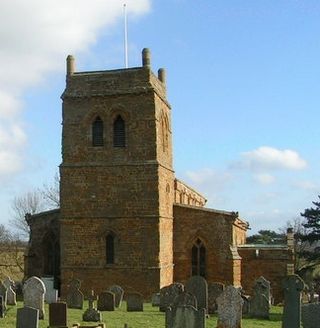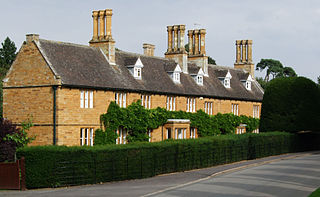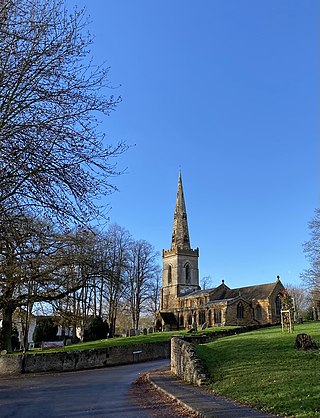
Holdenby House is a historic country house in Northamptonshire, traditionally pronounced, and sometimes spelt, Holmby. The house is situated in the parish of Holdenby, six miles (10 km) northwest of Northampton and close to Althorp. It is a Grade II* listed building.

Daventry District was a local government district in western Northamptonshire, England, from 1974 to 2021. The district was named after its main town of Daventry, where the council was based.

Welford is a village and civil parish in the West Northamptonshire unitary authority area of Northamptonshire, England, just south of the River Avon and the border with Leicestershire. At the 2011 Census, the population of the parish was 1,043.

Brixworth is a large village and civil parish in West Northamptonshire, England. The 2001 census recorded a parish population of 5,162, increasing to 5,228 at the 2011 census. The village's All Saints' Church is of Anglo-Saxon origin.
Thornby is a village and civil parish in West Northamptonshire in England. It has a Manor house. At the time of the 2001 census, the parish's population was 162 people, increasing to 189 at the 2011 Census. The village is bisected by the A5199 road between Northampton and Leicester and about 11 miles (17.7 km) north-west of Northampton town centre. It is about 1½ miles south of a junction with the A14 road which joins the M1 Motorway and M6 junction at Catthorpe with Felixstowe, Suffolk.

Staverton is a village and civil parish in the south-west of Northamptonshire, England. It is 2.3 miles west of Daventry, 7.9 miles east of Southam and 15.3 miles east of Leamington Spa. It straddles the A425 road from Daventry to Leamington. The Jurassic Way long-distance footpath between Banbury and Stamford passes through the village.

Spratton is a village and civil parish in the English county of Northamptonshire. The local government authority is West Northamptonshire. Before changes in 2021 it was governed by Daventry District Council. At the time of the 2001 census, the parish's population was 1,099 people, increasing to 1,150 at the 2011 Census. Spratton is 7.1 miles north of Northampton, 6.5 miles from Long Buckby and 11.4 miles from Daventry. The village is situated on the A5199 road.
Hollowell is a village and civil parish in West Northamptonshire in England. At the time of the 2001 census, the parish's population, including the nearby hamlet of Teeton, was 353 people, increasing to 385 at the 2011 Census. The village was originally a hamlet of Guilsborough, becoming a separate parish from 1850. Hollowell is mentioned in the Domesday Survey of 1086 as belonging the Bishop of Lincoln having "... 4 villeins with 1 bordar having 1 plough. It was, and is worth, 10 schillings. Bardi held (it) freely."

Harlestone is a small village and civil parish in West Northamptonshire, England. The village had a recorded population of 445 in the 2011 census.

Creaton is a village and civil parish in West Northamptonshire, England.

Cottesbrooke is a village and civil parish in West Northamptonshire in England. At the time of the 2001 census, the parish's population was 144 people, falling marginally to 143 at the 2011 census.

Sulgrave is a village and civil parish in West Northamptonshire, England, about 5 miles (8 km) north of Brackley. The village is just south of a stream that rises in the parish and flows east to join the River Tove, a tributary of the Great Ouse.

Kingsthorpe is a suburb and civil parish of Northampton, England. It is situated to the north of Northampton town centre and is served by the A508 and A5199 roads which join at Kingsthorpe's centre. The 2011 Census recorded the population of the district council ward as 4,477.
Stanwick is a village and civil parish in North Northamptonshire, England.

Chelveston is a small village in North Northamptonshire. It is about 2 miles (3.2 km) east of Higham Ferrers and 7 miles (11.3 km) east of Wellingborough on the B645 from Higham Ferrers to St Neots. To the south is the hamlet of Caldecott and the settlement of Chelston Rise which together comprise the civil parish of Chelveston cum Caldecott. The population is now included in the civil parish of Chelveston cum Caldecott.

Abthorpe is a village and civil parish in the valley of the River Tove in West Northamptonshire, England, about 4 miles (6.4 km) west of Towcester, 2 miles (3.2 km) northwest of Silverstone and approximately midway between London and Birmingham.
Nortoft was once a distinct hamlet between the Northamptonshire village of Guilsborough and the main road connecting Leicester and Northampton in the English Midlands.

West Northamptonshire is a unitary authority area covering part of the ceremonial county of Northamptonshire, England, created in 2021. By far the largest settlement in West Northamptonshire is the county town of Northampton. Its other significant towns are Daventry, Brackley and Towcester; the rest of the area is predominantly agricultural villages though it has many lakes and small woodlands and is passed through by the West Coast Main Line and the M1 and M40 motorways. The district includes the site of the Roman town of Bannaventa, and the grade I listed Althorp House and its estate.

Cottesbrooke Hall and the Cottesbrooke estate in Northamptonshire, England, is a Grade I listed country house and estate.

Brixworth railway station on the Northampton and Market Harborough railway opened on 16 February 1859 serving the village of Brixworth, Northamptonshire, England. It ran half a mile west of the village towards the village of Creaton along what remains as Station Road. It was part of the London and North Western Railway. Apart from the passenger service the line also enabled a large ironstone field near the village to be developed which had been an important consideration in developing the line.
















